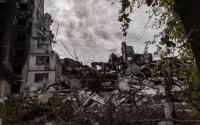22 November 2004David B. Willis and Walter W. Enloe
The news from Washington this past week had eerie echoes of the lead-up to the war in Iraq. Now that George Bush has been re-elected President what might we anticipate as future scenarios? If the doctrine of pre-emption is followed the next conflict is likely to go nuclear.
One plausible scenario is that the Neocons will stop at nothing to bring the other members of the Axis of Evil to their knees. There has already been considerable talk along these lines following the election. The Neocons have said as much when they have called for imminent regime change in these countries in documents such as the Project for the New American Century.
Syria might be the first step in this plan, accused of harboring the hidden WMDs of Saddam Hussein or insurgents from Iraq, for example. Cambodia or Laos all over again. An "incursion" and then a "popular uprising" will depose the Assad regime, which will then be shown to have colluded with Hezbollah and Iran in supporting "terrorism." War with Iran will follow and with it the breaking of the nuclear taboo.
Other possible scripts could be triggered by preemptive strikes, the preeminent tool of the Neocons, on either Iranian or North Korean nuclear facilities. The consequences of these strikes would likely lead to the use of battlefield nuclear weapons as well.
In any of the scenarios it is simply assumed that violence is the solution to any difficult problems the US encounters, yet there are simply not enough conventional forces or weapons to adequately wage war, if winning at all costs is the objective. This is despite the fact that Americans are spending $350-400 billion a year on the greatest array of military power the world has ever seen. These resources are being spread around the globe to more than 700 bases being maintained by the American military.
The figure for American defense spending is seven or eight times that of the next highest spenders, Russia and China, at $60 and $50 billion, respectively. The Axis of Evil comes in at less than a billion dollars total, but Americans are still scared. Perhaps what they should really be more scared of is the financial consequences.
The US debt will climb to $7 trillion a year in 2004, five times the entire debt of the third world. Other countries, notably Japan and China, hold one-third of that debt. This is at a time, we might note, that the Harvard economist Jeffrey Sachs has proposed that the world's poverty could be eliminated with an investment of $150 billion.
There is still the possibility of a peaceful rapprochement, but at this stage how likely will that be? Whichever of the scenarios prevails will depend on the will and direction of the next American government. What will these future scenes mean for the world if they do indeed turn nuclear?
We need look only as far as Hiroshima and Nagasaki for the answers to this question. One of us grew up in Hiroshima in the 1960s, an American missionary child confronted, understandably, by neighboring children and even adults for the devastation that had been wrought by his countrymen. Later, as the principal of the Hiroshima International School and then in schools in Minnesota, he actively supported movements for world peace.
Having brought some consciousness of our culpability in the woes of the last hundred years (and the past several years), we now need to invoke a healing image for the future. We might begin with what Jonathan Schell, in his brilliant book The Fate of The Earth, elaborated as the concept of universal parenthood. After the systematic destruction during the past century of innocent beings in Nanking, Guernica, Auschwitz, Hiroshima, Nagasaki, My Lai, Israel, Gaza, Iraq, and now Fallujah, among others, including the World Trade Center, the very idea of human extinction makes all of us, whether we have children or not, parents of the next generation.
First we need to remind ourselves of the messages of World War II holocausts, then by the past and present threats of nuclear extinction, and finally when human beings glimpsed a holistic image of the Earth as seen from the moon. At that time we saw a world increasing interdependent, complex, and changing: technologically, economically, culturally, ecologically. The sheer beauty of the living reality of Earth itself, devoid of political boundaries and cultural landscapes, conjures up a new sense of hope and urgency that acknowledges and yet transcends cultural, racial, religious, and civil differences.
The image is one of the whole of humanity in interdependent relationship and intertwined with the whole of nature. It is a spiritual view of the world that radiates the interconnectedness of life. In this context Hiroshima's and Nagasaki's spirits remind us of the fragility of human and natural ecosystems and of the fact that the apocalyptic problems our planet faces, other than natural disasters and direct encounters with physical fragments of the universe, are specifically human problems.
What also characterizes the past hundred years is a paradox of the human spirit and human conduct. Hope remains. Through an image of Earth as seen from the moon to planetary satellites, global communication, ecological and economic interdependencies, and through organizations like the United Nations and our fragile Universal Declaration of Human Rights, we have a greater sense of the interconnectedness of the world's people and places.
In the words of Dr. Martin Luther King, days before his 1968 assassination, "The world is more and more of a neighborhood. But is it any more of a brotherhood? If we don't learn to live together as brothers and sisters, we shall perish together as fools."
David Blake Willis, Professor of Cultural Studies at Soai University, Osaka, Japan, has published research on globalization, transnational societies, and creolization. Walter Enloe is a Professor of Education at Hamline University, St. Paul, Minnesota, USA. He is a founding member of the 1000 Cranes peace project and the former headmaster of the Hiroshima International School.






